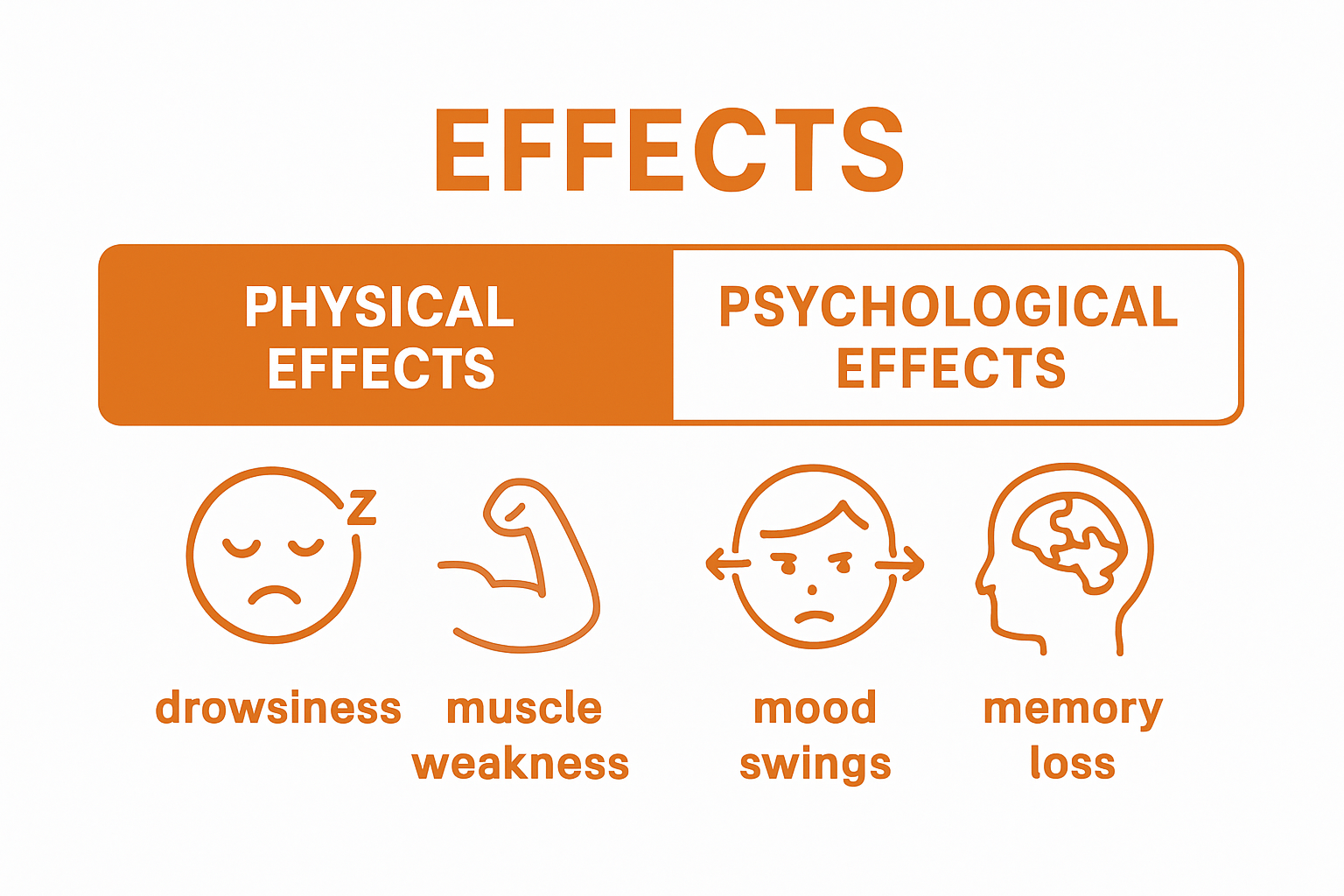Xanax is one of the most widely prescribed drugs for anxiety across the United States and nearly 50 million Xanax prescriptions are written each year. You might expect a medication so common to have predictable and manageable effects. The wild part is how unpredictable these side effects can be and how some, like paradoxical anxiety and hallucinations, can catch people completely off guard.
Table of Contents
- What Are Xanax Side Effects And Why Do They Occur?
- The Importance Of Understanding Xanax Side Effects
- How Xanax Affects The Brain And Body
- Common And Less Known Xanax Side Effects
- Recognizing And Addressing Xanax Side Effects
Quick Summary
| Takeaway | Explanation |
|---|---|
| Understand Xanax side effects | Awareness of side effects is crucial for safe medication use. Discuss these with your healthcare provider. |
| Recognize critical warning signs | Severe symptoms like mood swings or breathing issues require immediate medical attention. |
| Monitor your reactions to Xanax | Keep a symptom journal to track any unusual changes in your health while on this medication. |
| Avoid unmonitored dosage changes | Modifying your dosage without professional guidance can lead to severe complications or dependence. |
| Discuss interactions with other medications | Inform your doctor about all medications you are taking to avoid dangerous interactions. |
What Are Xanax Side Effects and Why Do They Occur?
Xanax, a prescription medication primarily used to treat anxiety and panic disorders, belongs to a class of drugs called benzodiazepines. When consumed, it interacts directly with the central nervous system, producing significant physiological and psychological effects. Research from the National Institute of Mental Health indicates that understanding these side effects is crucial for safe and responsible use.
The Neurological Mechanism Behind Xanax Side Effects
The side effects of Xanax stem from its interaction with gamma-aminobutyric acid (GABA) neurotransmitters in the brain. By enhancing GABA activity, Xanax produces a calming effect that reduces anxiety and neurological excitability. However, this same mechanism can trigger various side effects:
- Decreased cognitive function
- Potential motor skill impairment
- Disrupted emotional regulation
Common Physical and Psychological Side Effects
Xanax side effects can manifest across multiple bodily systems. Physical reactions might include drowsiness, dizziness, and potential coordination challenges. Psychological side effects can range from mild mood changes to more complex emotional responses. According to medical research from the Mayo Clinic, these side effects can vary based on individual physiology, dosage, and duration of use.
People considering or currently using Xanax should discuss potential side effects thoroughly with healthcare professionals. If you or a loved one are struggling with prescription medication use, learn more about our Xanax rehab in San Diego, where compassionate experts can provide personalized guidance and support.
The Importance of Understanding Xanax Side Effects
Understanding the potential side effects of Xanax is crucial for anyone using or considering this medication. Benzodiazepines like Xanax can significantly impact physical and mental health, making informed awareness essential for safe usage. Research from the National Institutes of Health highlights the critical need for patient education and proactive medical oversight.
Risks of Uninformed Medication Use
Ignoring or minimizing Xanax side effects can lead to serious health complications. Potential risks include developing dependency, experiencing cognitive impairment, and encountering unexpected physiological reactions. Key considerations for patients include:
- Potential for developing substance use disorder
- Risk of long-term neurological changes
- Increased vulnerability to mental health complications
Comprehensive Side Effect Awareness
Knowledge of Xanax side effects empowers patients to make informed decisions about their treatment. This awareness allows individuals to recognize warning signs, communicate effectively with healthcare providers, and adjust treatment plans accordingly. Learn about potential drug interactions with our guide on Xanax and Gabapentin risks, which provides critical insights into medication safety.
Moreover, understanding side effects helps patients differentiate between normal medication responses and potentially dangerous reactions. Medical professionals recommend continuous monitoring and open communication about any unusual symptoms or changes in physical or mental health while taking Xanax.
How Xanax Affects the Brain and Body
Xanax operates as a powerful central nervous system depressant, interacting with complex neurological mechanisms to produce its therapeutic and potentially dangerous effects. According to neurological research from Johns Hopkins Medicine, the drug fundamentally alters brain chemistry and physiological responses.
Neurochemical Interaction and GABA Receptors
Xanax specifically targets GABA (gamma-aminobutyric acid) neurotransmitters, which are responsible for reducing neuronal excitability throughout the nervous system. By enhancing GABA activity, Xanax produces a profound calming effect that simultaneously suppresses anxiety and modulates multiple bodily functions. The neurochemical interactions create a cascade of physiological changes:
- Decreased neural transmission speed
- Reduced muscle tension
- Suppression of stress response mechanisms
Systemic Physiological Responses
Beyond brain chemistry, Xanax influences multiple bodily systems. The medication can dramatically impact cardiovascular, respiratory, and muscular functions. These systemic effects explain why users might experience widespread physical symptoms. Learn more about the potential risks of Xanax blackouts and understand how the drug can temporarily impair cognitive and motor functions.
Individuals respond differently to Xanax based on factors like metabolism, overall health, and concurrent medications. Medical professionals emphasize the importance of personalized monitoring and understanding individual physiological responses to this potent medication.
Common and Less Known Xanax Side Effects
Xanax side effects range from mild and manageable to potentially severe and life-altering. Understanding these effects helps patients make informed decisions about their medication and recognize potential warning signs. Research from the National Library of Medicine emphasizes the importance of comprehensive awareness about prescription medication reactions.
Immediate Physical Side Effects
Short-term physical side effects can manifest quickly after consuming Xanax.

- Persistent drowsiness
- Significant muscle weakness
- Impaired coordination
- Increased salivation
- Altered sexual function
Psychological and Neurological Complications
Beyond physical symptoms, Xanax can produce complex psychological side effects that potentially impact mental health and cognitive functioning. Learn more about the risks of Xanax interactions to understand the broader implications of this medication. Some less recognized psychological side effects include:
- Unexpected mood fluctuations
- Memory processing difficulties
- Potential hallucinations
- Increased anxiety paradoxically
- Temporary confusion
Medical professionals recommend continuous monitoring and open communication about any unusual symptoms experienced while taking Xanax. Patients should never modify their prescribed dosage without professional medical guidance.
A quick reference table summarizing the most common and lesser-known side effects of Xanax can help readers visually compare these effects and identify which ones may require more attention.
| Side Effect Type | Example Side Effects | Typical Severity |
|---|---|---|
| Immediate Physical | Drowsiness, muscle weakness, impaired coordination, increased salivation, altered sexual function | Mild to Moderate |
| Psychological/Neurological | Mood fluctuations, memory processing difficulties, hallucinations, paradoxical anxiety, temporary confusion | Moderate to Severe |
| Critical Warning Signs | Severe allergic reactions, intense mood swings, cognitive impairment, respiratory difficulties | Severe (Seek help) |
Recognizing and Addressing Xanax Side Effects
Navigating Xanax side effects requires a comprehensive understanding of symptom recognition, medical intervention, and proactive health management. Patients must develop acute awareness of potential physiological and psychological changes that might indicate adverse reactions. Research from the American Psychiatric Association highlights the critical importance of early detection and professional guidance.
Critical Warning Signs
Certain side effects demand immediate medical attention and should never be ignored. These potentially serious symptoms signal the need for urgent healthcare consultation:
- Severe allergic reactions
- Intense mood swings or suicidal thoughts
- Significant cognitive impairment
- Unexplained physical weakness
- Respiratory difficulties
Professional Management Strategies
Addressing Xanax side effects involves collaborative approaches between patients and healthcare providers. This process includes comprehensive medication reviews, potential dosage adjustments, and exploring alternative treatment options. Explore our specialized Xanax rehabilitation resources to understand comprehensive support mechanisms for managing prescription medication challenges.
Patients should maintain open communication with their healthcare providers, documenting and reporting any unusual symptoms. Keeping a detailed symptom journal can help medical professionals make informed decisions about treatment modifications and potential medication alternatives.
Take Control of Your Recovery From Xanax Side Effects Today
Understanding the real impact of Xanax side effects is the first step to taking back your life. If you’ve found yourself struggling with unwanted symptoms like persistent drowsiness, mood swings, or increasing anxiety, you are not alone. Managing these challenges can feel overwhelming, especially when you are working to protect both your mental and physical health as described in our article. Facing uncertainty about your next steps or how to safely address these complex side effects can be tough on you and your loved ones.
Healthy Life Recovery in San Diego offers more than just information. Our team provides medically supervised detox, a compassionate support system, and innovative therapies that target not only addiction but also the co-occurring mental health issues often tied to medications like Xanax. Take the next step and explore the full spectrum of our care and evidence-based treatment options at Healthy Life Recovery. Ready to begin your path to a healthier, substance-free future? Visit our San Diego rehab programs or browse our main Healthy Life Recovery website right now. You deserve expert help and a personalized solution today.
Frequently Asked Questions
What are the common side effects of Xanax?
Common side effects of Xanax include drowsiness, dizziness, impaired coordination, muscle weakness, and altered sexual function. These can vary based on individual factors such as dosage and duration of use.
How does Xanax affect the brain?
Xanax interacts with GABA neurotransmitters in the brain, enhancing their activity to produce a calming effect. This can lead to decreased cognitive function and potential motor skill impairment.
What should I do if I experience severe side effects from Xanax?
If you experience severe side effects such as intense mood swings, significant cognitive impairment, or respiratory difficulties, seek immediate medical attention. It’s important to communicate openly with your healthcare provider about any unusual symptoms.
Can Xanax cause psychological side effects?
Yes, Xanax can produce psychological side effects including mood fluctuations, memory processing difficulties, and paradoxically increased anxiety. Continuous monitoring and communication with a healthcare professional are essential to managing these effects.







